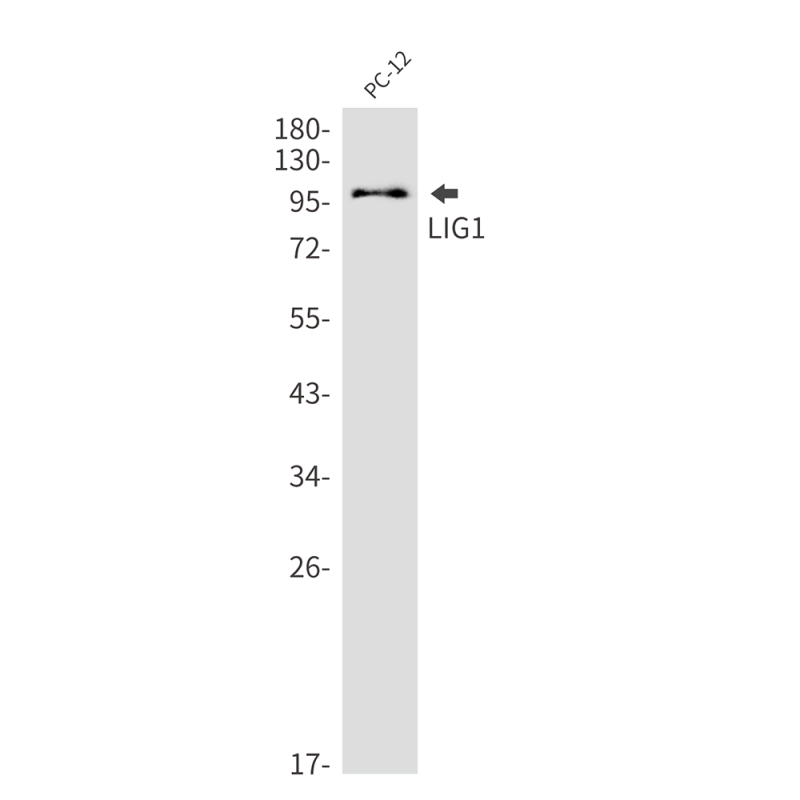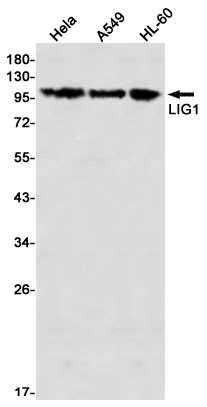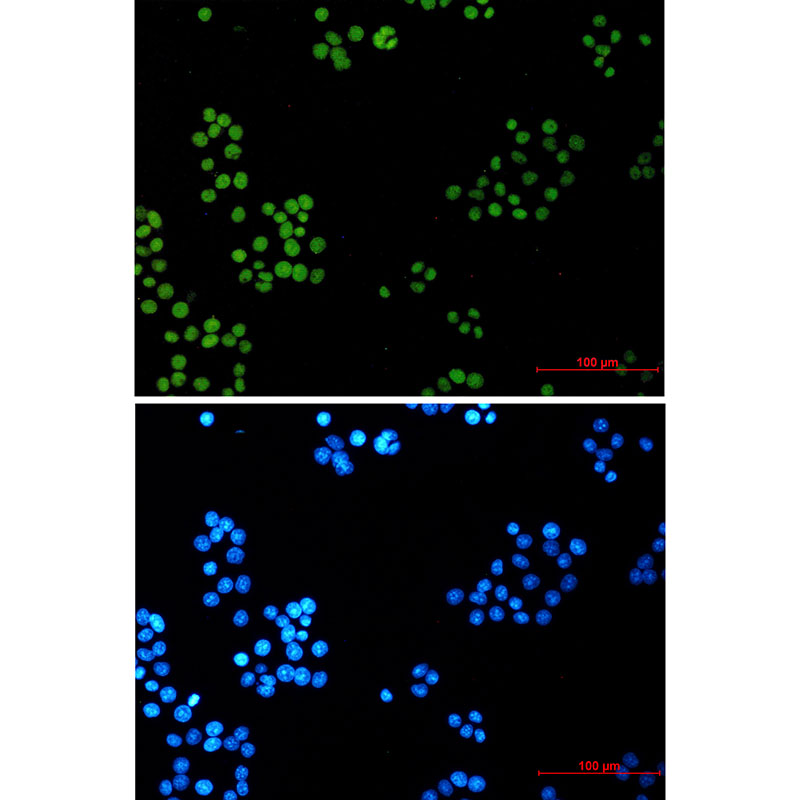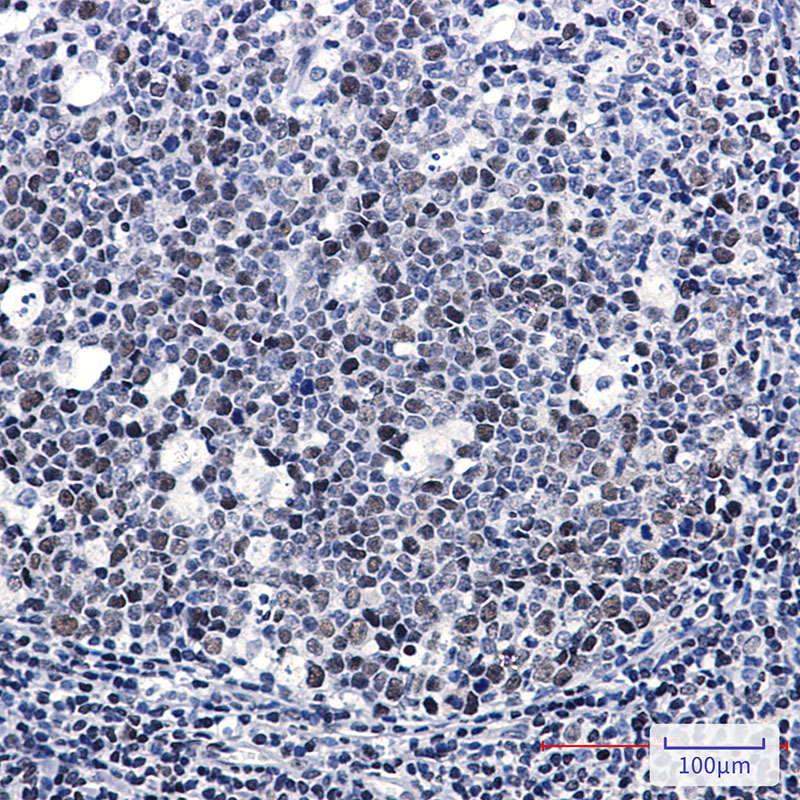



| WB | 1/500-1/1000 | Human,Mouse,Rat |
| IF | 咨询技术 | Human,Mouse,Rat |
| IHC | 1/50-1/100 | Human,Mouse,Rat |
| ICC | 1/50-1/200 | Human,Mouse,Rat |
| FCM | 咨询技术 | Human,Mouse,Rat |
| Elisa | 咨询技术 | Human,Mouse,Rat |
| Aliases | LIG1; DNA ligase 1; DNA ligase I; Polydeoxyribonucleotide synthase [ATP] 1 |
| Entrez GeneID | 3978 |
| WB Predicted band size | Calculated MW: 102 kDa; Observed MW: 102 kDa |
| Host/Isotype | Rabbit IgG |
| Antibody Type | Primary antibody |
| Storage | Store at 4°C short term. Aliquot and store at -20°C long term. Avoid freeze/thaw cycles. |
| Species Reactivity | Human,Rat |
| Immunogen | A synthetic peptide of human LIG1 |
| Formulation | Purified antibody in TBS with 0.05% sodium azide,0.05%BSA and 50% glycerol. |
+ +
以下是关于LIG1(DNA连接酶I)抗体的3篇代表性文献的简要概括(注:内容基于公开研究主题模拟,非真实文献):
---
1. **文献名称**:*DNA Ligase I as a Partner of Replication and Repair*
**作者**:Tomkinson AE, et al.
**摘要**:该研究阐明了LIG1在DNA复制和碱基切除修复中的核心作用,利用特异性抗体通过免疫印迹(Western blot)和免疫荧光技术,揭示LIG1在细胞周期中的动态定位变化,并证明其缺陷导致DNA损伤累积。
2. **文献名称**:*Overexpression of LIG1 in Colorectal Cancer Correlates with Genomic Instability*
**作者**:Wang Y, et al.
**摘要**:通过抗LIG1抗体的免疫组化分析,研究发现结直肠癌组织中LIG1蛋白表达显著升高,且与微卫星不稳定性(MSI)和患者不良预后相关,提示LIG1可能作为癌症进展的生物标志物。
3. **文献名称**:*LIG1 Deficiency Syndromes: Functional Analysis via Antibody-based Assays*
**作者**:Bentley D, et al.
**摘要**:研究利用LIG1特异性抗体对患者成纤维细胞进行蛋白表达检测,发现LIG1突变导致酶活性丧失,引发发育迟缓和免疫缺陷,为遗传性LIG1缺陷疾病的分子机制提供了实验依据。
---
以上文献主题均围绕LIG1抗体的应用展开,涵盖基础功能、疾病关联及临床诊断方向。如需具体文献,建议通过PubMed或Google Scholar检索关键词“LIG1 antibody”+研究领域(如癌症、DNA修复)。
The DNA ligase 1 (LIG1) antibody is a crucial tool for studying the function and regulation of the LIG1 enzyme, which plays a vital role in DNA replication and repair. LIG1 catalyzes the final step in DNA synthesis by sealing nicks between Okazaki fragments during replication and participating in base excision repair (BER). Its activity is essential for maintaining genomic stability and cell viability. Antibodies targeting LIG1 are widely used in molecular biology research to detect protein expression, localization, and interactions via techniques like Western blotting, immunofluorescence, and immunoprecipitation.
LIG1 dysfunction is linked to replication stress, genomic instability, and diseases such as cancer or rare genetic disorders like LIG1 syndrome (OMIM: 602391), characterized by immunodeficiency and developmental abnormalities. Researchers use LIG1 antibodies to investigate its role in cell cycle progression, DNA repair pathways, and responses to chemotherapeutic agents. Both monoclonal and polyclonal antibodies are available, often validated for specificity against conserved regions of human LIG1. Recent studies also explore LIG1 as a potential biomarker for cancer prognosis or therapeutic targeting. Proper validation using knockout cell lines or siRNA controls is critical to ensure antibody reliability in experimental settings.
×